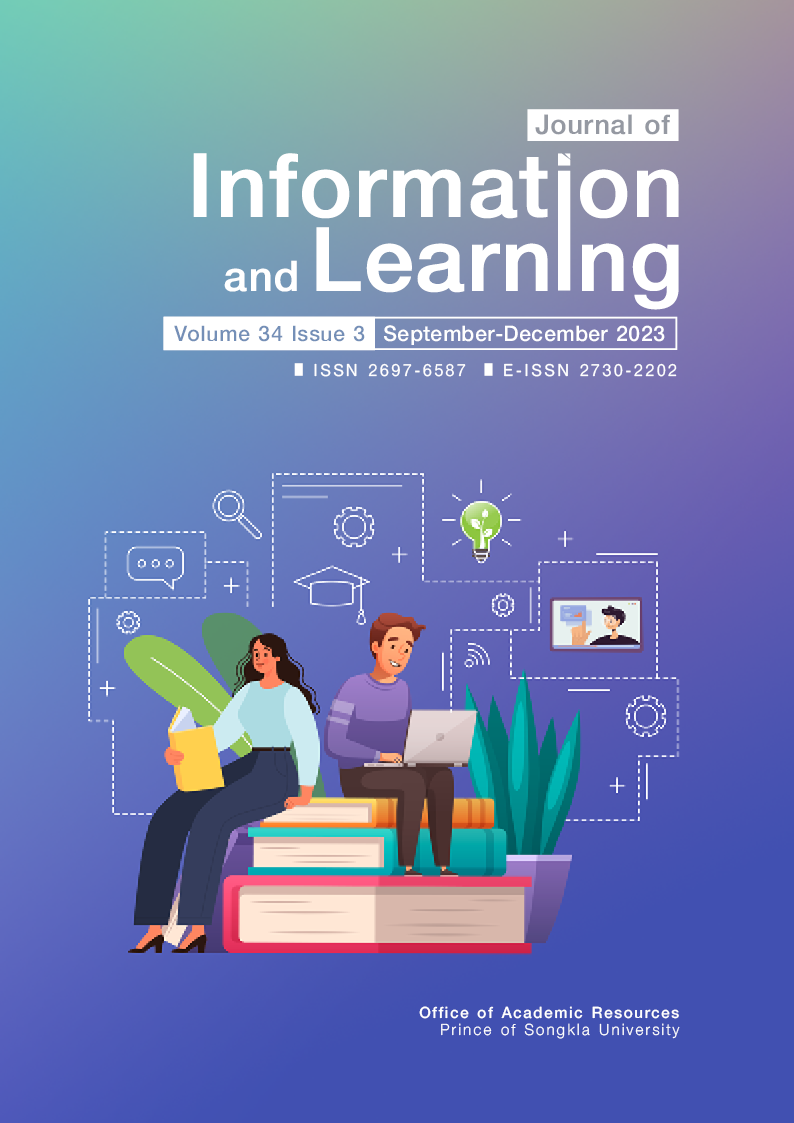A Support Tool for Training in Writing Animation Movie Scripts
Main Article Content
Abstract
This research aims to design and develop an animation scriptwriting support tool with an ontology as a knowledge base and to study the effectiveness of the tool in improving students' animation scriptwriting skills. In design and development, a schema of the crafted ontology stores the knowledge related to principles of animation script writing, and it is utilized to support students in understanding abstractedness of relations within script schemes. In this study, the experimental population and chosen samples were 33 undergraduate students from the entire class of 45 students of the Animation and Digital Media Program at Bansomdejchaopraya Rajabhat University by a simple random sampling method. The research instruments include the developed training supporting tool, a form for evaluating an effectiveness of the tool, and a form for evaluating a usage suitability of the tool. The evaluation forms were calculated with the Item-Objective Congruence (IOC) index and revealed indicator scores in a range of 0.67 to 1.00. Mean and standard deviation were used for data analysis.
Results of this research indicates that the developed tool a good result in terms of effectiveness (M = 4.10, SD = 0.43) and is evaluated for a usage suitability for a high suitability (M = 4.33, SD = 0.54). The evaluators found the design of the supporting tool impressive as it helps to exemplify complex principles within writing script schemes and leads students to acquire the necessary knowledge and skills by fostering a conducive learning environment by partitioning these components into distinct and coherent sections and encouraging thoughtful reflection of students’ own results. Furthermore, the results of using the tool for assisting students in developing animation scriptwriting skills showed significant improvements in learners, as 34% of students displayed greater awareness of the mandatory structure in a scriptwriting.
Article Details

This work is licensed under a Creative Commons Attribution-NonCommercial-NoDerivatives 4.0 International License.
The Journal of Information and Learning is operated by the Office of Academic Resources, Prince of Songkla University. All articles published in the journal are protected by Thailand copyright law. This copyright covers the exclusive rights to share, reproduce and distribute the article, including in electronic forms, reprints, translations, photographic reproductions, or similar. Authors own copyrights in the works they have created as well as the Office of Academic Resources. The Journal reserves the right to edit the language of papers accepted for publication for clarity and correctness, as well as to make formal changes to ensure compliance with the journal's guidelines. All authors must take public responsibility for the content of their paper.
References
Demorest, A. P., & Alexander, I. E. (1992). Affective scripts as organizers of personal experience. Journal of Personality, 60(3), 645-663. https://doi.org/10.1111/j.1467-6494.1992.tb00924.x
Faridah, I., Sari, F. R., Wahyuningsih, T., Oganda, F. P., & Rahardja, U. (2020, October 23-24). Effect digital learning on student motivation during Covid-19 [Paper presentation]. The 8th International Conference on Cyber and IT Service Management (CITSM), Pangkal, Indonesia. https://ieeexplore.ieee.org/document/9268843
Gutierrez, P. (2014). The power of scriptwriting!: Teaching essential writing skills through podcasts, graphic novels, movies, and more. Teachers College Press.
Jaiboonlue, P., & Na Chai, W. (2023). A design of an ontology for animation scripts writing towards the learning of necessary elements and relationship among them. Journal of Information Science, 41(1), 66-85. https://doi.org/10.14456/jiskku.2023.4
Khalili, S. (2018). Analysing the advantages of Aristotle’s two-act structure in comparison with Syd Field’s three-act structure in short comedic animation scriptwriting. Journal of Screenwriting, 9(3), 265-277. https://doi.org/10.1386/josc.9.3.265_1
Kinnunen, T., Leisma, H., Machunik, M., Kakkonen, T., & Lebrun, J. L. (2012, April). SWAN-scientific writing AssistaNt. a tool for helping scholars to write reader-friendly manuscripts [Conference session]. The The 13th Conference of the European Chapter of the Association for Computational Linguistics (EACL 2012), Avignon, France. http://dx.doi.org/10.13140/2.1.3284.4808
Ladopoulou, G., & Dimitriadis, G. (2022). The female perspective: Stereotypes vs. realism in film character Portrayal and development [Diploma Thesis, Aristotle University of Thessaloniki]. IKEE/Aristotle University of Thessaloniki – Library. http://ikee.lib.auth.gr/record/341787
Lombardo, V., & Pizzo, A. (2014, November 3-6). Ontology–based visualization of characters’ intentions [Paper presentation]. 7th International Conference on Interactive Digital Storytelling (ICIDS 2014), Singapore, Singapore. http://dx.doi.org/10.1007/978-3-319-12337-0_18
Marx, C. (2007). Writing for animation, comics, and games. CRC Press. https://www.sciencedirect.com/book/9780240805825/writing-for-animation-comics-and-games
Na Chai, W., Ruangrajitpakorn, T., & Supnithi, T. (2017, December 4-8). A tool for data acquisition of thinking processes through writing [Paper presentation]. The 25th International Conference on Computers in Education (ICCE 2017), Christchurch, New Zealand. https://www.researchgate.net/publication/376808252_A_Tool_for_Data_Acquisition_of_Thinking_Processes_through_Writing
Na Chai, W., Ruangrajitpakorn, T., & Supnithi, T. (2019, December 2-6). A tool for learning of cognitive process by analysis from exemplar documents [Paper presentation]. The 27th International Conference on Computers in Education (ICCE 2019), Kenting, Taiwan. https://www.researchgate.net/publication/369659210_A_Tool_for_Learning_of_Cognitive_Process_by_Analysis_from_Exemplar_Documents
Redvall, E. N. (2009). Scriptwriting as a creative, collaborative learning process of problem finding and problem solving. MedieKultur: Journal of Media and Communication Research, 25(46), 34-55. http://dx.doi.org/10.7146/mediekultur.v25i46.1342
Røssaak, E. (2006). Figures of sensation: Between still and moving images. Amsterdam University Press. https://www.jstor.org/stable/pdf/j.ctt46n09s.23.pdf
Scott, J. (2003). How to write for animation. The Overlook Press. https://books.google.co.th/books?id=mRKEDwAAQBAJ&lpg=PP6&dq=How%20to%20write%20for%20animation&lr&hl=th&pg=PP6#v=onepage&q=How%20to%20write%20for%20animation&f=false
Takhom, A., Trakul Taweekoon, K., Chotimongkol, A., Porkaew, P., Na-Thalang, S. S., & Supnithi, T. (2011, November-December 28-2). EAGLE: An error tAGger for learners of English [Paper presentation]. The 19th International Conference on Computers in Education (ICCE 2011), Chiang Mai, Thailand. https://www.researchgate.net/profile/Ananlada-Chotimongkol/publication/267805289_EAGLE_an_Error_tAGger_for_Learners_of_English/links/54b7e1200cf2c27adc474cce/EAGLE-an-Error-tAGger-for-Learners-of-English.pdf
Torres Martín, C., Acal, C., El Homrani, M., & Mingorance Estrada, Á. C. (2021). Impact on the virtual learning environment due to COVID-19. International Journal of Educational Technology in Higher Education, 13(2), 582. https://doi.org/10.3390/su13020582
Vrandečić, D. (2009). Ontology evaluation. Springer. https://link.springer. com/chapter/10.1007/978-3-540-92673-3_13
Wright, J. A. (2013). Animation writing and development: From script development to pitch. Focal Press. https://theswissbay.ch/pdf/Gentoomen%20Library/Animation/Animation_Writing_Development_Script_Pitch.pdf
WriterDuet. (2022, January 5). Effortless screenwriting. WriterDuet. https://www.writerduet.com
Zhang, F., Hwa, R., Litman, D., & Hashemi, H. B. (2016, June 12-17). Argrewrite: A web-based revision assistant for argumentative writings [Paper presentation]. The 15th Annual Conference of the North American Chapter of the Association for Computational Linguistics (NAACL HLT 2016), San Diego California, USA. http://dx.doi.org/10.18653/v1/N16-3008


